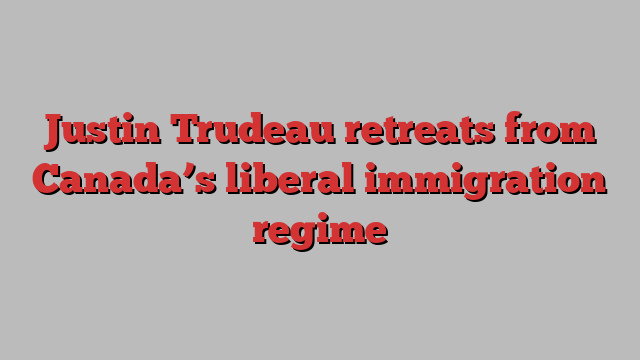
Unlock the Editor’s Digest for free
Roula Khalaf, Editor of the FT, selects her favourite stories in this weekly newsletter.
Justin Trudeau this week moved to quell a public backlash to one of the world’s most progressive migration policies by rolling back Canada’s foreign worker scheme.
Trailing in polls ahead of an election next year, the prime minister announced measures to slash the number of new arrivals. But executives worry the measures will curb their supply of cheap labour.
Simranzeet Singh, manager of policy at the Ontario Chamber of Commerce, said that more consultation was needed to ensure “changes do not inadvertently harm our economy or critical services”.
Trudeau told reporters on Monday that the government was “looking at the various (migration) streams to make sure that, as we move forward, Canada remains a place that is positive in its support for immigration but also responsible in the way we integrate and make pathways for success”.
The move marked an abrupt change for Trudeau, who has championed Canada’s openness to migrants and welcomed refugees from war-ravaged countries including Syria and Ukraine. In 2015, he greeted Syrian refugees at Toronto airport by handing them winter jackets and declaring: “You are home.”
The foreign workers programme is credited with helping Canada recover from the pandemic but has been increasingly blamed for the high cost of housing, pressure on the healthcare system and rising youth unemployment.
Conservative party leader Pierre Poilievre has made Canada’s skyrocketing cost of living and sluggish economy a central element of his election campaign.
On Thursday Poilievre claimed Trudeau’s government had “destroyed our immigration system”.
“We have to have a smaller population growth,” he said.
Canada follows the UK and Germany in cracking down on immigration in the face of public disquiet about an influx of foreigners. Immigration has also become central to this year’s US election, with Democratic candidate Kamala Harris under fire for an increase in the number of migrants crossing the southern border from Mexico during the Biden administration.
Canada has welcomed 1.63mn new citizens since January 2018 with nearly one-third coming from India, the Philippines or China, according to official data.
In 2021, more than 8.3mn people, or almost one-quarter of Canada’s population, were migrants, according to official data. By comparison, in 2022 about 14 per cent of the UK’s almost 70mn people were born overseas, according to Oxford university’s migration observation centre.
David Coletto, chief executive of Ottawa-based polling firm Abacus Data, said that migration was one reason for the opposition Conservatives’ 17 point polling lead over Trudeau’s Liberals.
“Our data shows only one in four think the country is going in the right direction,” he said.
Canada’s population hit 40mn last year after growing by more than 1mn in a year. Temporary and permanent migration accounted for 96 per cent of this population growth.
In November, two-thirds of Canadians surveyed said immigration was “too high” and 31 per cent said “way too high”, Coletto said. A Metropolis Institute and the Association for Canadian Studies poll in March 2024 found “one in two Canadians” said there were too many immigrants.
Trudeau’s new measures would slash from 20 per cent to 10 per cent the share of low-wage temporary foreign workers that Canadian employers can hire — reversing a 2022 policy that has increased the country’s stock of temporary foreign workers to nearly 3mn people. Trudeau has hinted at broader immigration reform in the autumn.
In January, Ottawa also capped the number of international students for the year at 360,000. Immigration minister Marc Miller said at the time that the supply of foreign students had “become so lucrative that it opened a path for its abuse” by profiteering education institutions and would-be students.
Michael Bonner, a ministerial adviser in the previous Conservative government, said companies use the foreign worker schemes as a central part of their business model to keep wages and prices low.
“This is bad enough, but it also prices Canadians out of the labour market,” he said.
The new measures include an exemption for agricultural producers, particularly those in remote locations where it is difficult to meet labour needs locally.
Dan Kelly, president of the Canadian Federation of Independent Business, the country’s largest businesses association, said labour shortages “will only get worse in agriculture, caregiving and skilled trades, as well as in rural areas”.
He called the criticism of foreign workers “unfounded political attacks”, adding that “94 per cent of employers” who rely on the programme were compliant with protection measures.
The Canadian government has also come under pressure to stem the flow of foreign workers across the border with the US, which has strained relations between the governments.
“US lawmakers are calling to harden the northern border with Canada because of the fears of illegal migration from Canada. So, stemming the flow of these visas will bolster US relations,” said Glenn Cowan, founder and chief executive of One9, a venture capital company focused on security.